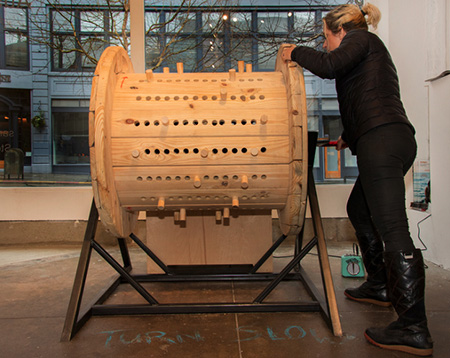
A new exhibition at Core Gallery of hand-made musical instruments by sculptor-composer duo, Sarah Fansler Lavin and Stephanie Wood, brings to mind the whole history of avant-garde music in Seattle and, more importantly, the considerable pedigree the city has in catalyzing such creative undertakings.
As a teenager I attended New Dimensions in Music concerts at Cornish Institute of Allied Arts, where I heard composers like Joan Franks Williams (the director), Ursula Mamlok, Morton Subotnick and Charles Wuorinen. Cornish is the birthplace of the prepared piano, long associated with a faculty member at the time, John Cage. Invented because the Cornish dance stage had no room for an orchestra — or Cage’s four-person ensemble — the prepared piano involved “nine screws, eight bolts, two nuts and three strips of leather” inserted over and under hammers and mallets inside the piano. The dance concert was by Syvilla Fort, a former student of Katherine Dunham, who became an important choreographer and teacher in New York. Cage’s accompaniment to her “Bacchanale” (1940) had international ramifications for 20th-century music.
Cage was the most wayward student of exiled giant of modern music Arnold Schoenberg, who taught at University of Southern California. Other composers before Cage had altered musical instruments, among them Henry Cowell, Maurice Delage and Heitor Villa-Lobos, but Cage’s manipulations created a different sound, at once muffled and eerie. It grew out of another first, Cage’s all-percussion student ensemble he had formed in 1938.
A composer who used only his self-invented musical instruments, Harry Partch, had visited Seattle but it was not until 2014 that his vast collection of musical instruments was moved to the School of Music at the University of Washington, where a former disciple, Charles Corey, was professor of music. The Harry Partch Instrumentarium performs his music, influenced by polytonal Asian sounds like the Javanese gamelan orchestras with unfixed pitches, on his “chromolodeon, kithara, crychord and cone gongs.” Regular concerts are now scheduled, keeping Partch’s music alive and still influential.
Seattle composer Phillip Arnautoff is at pains to state he was “not a disciple [of Partch]. I followed my own path.” They met in the 1960s in San Francisco. Arnautoff is among the most evident of hand-made musical instrument makers who also performs on them. His “Soliloquy: A Ritual of Communion with Vibrating Strings” (2001) was recorded on Periplum and performed along with his “Variations for Cello” (2005-2010) which adapts a cello. Music critic Christopher DeLaurenti called Arnautoff’s music “spiritually transformative. . [and] potentially transcendent.”
The Fluxus Group which was, according to another critic, “neither school nor movement,” privileged iconoclastic versions of sculpture by Yoko Ono, George Brecht, Ben Vautier, Wolf Vostell and founder George Maciunas, the latter attending an important 1977 Fluxus festival at and/or gallery in Seattle a few months before his death.
During Maciunas’ performance, local artist Dennis Evans performed his own work, standing on a ladder and dripping water onto stone pebbles. This was “One Hundred Discrete Sounding Stones for Puget Sound” (1977), which was also performed at various venues in the Pacific Northwest, including the Seattle Art Museum Pavilion. “One Hundred Discrete Soundings” attracted the attention of curators at the Smithsonian American Art Museum, resulting in the inclusion of his sculptures in an important exhibit of American musical instruments.
Evans built upon Fluxus’ use of container boxes; their enthusiasm for unplanned, spontaneous events; and their use of pseudonyms and altered personae. His was “Ubu Waugh,” a reference to French Dada idol Alfred Jarry and satirical British novelist Evelyn Waugh. Brecht’s “reintroduction of humor into art” was crucial for Evans, who continues to work today. His music and that of other local composers are heard at The Chapel at Good Shepherd Home and at the Jack Straw Foundation, the successor to nonprofit public radio station KRAB-FM. Evans claimed that each “sounding stone” or rock was pitched and could only be heard properly when rain fell on it.
With such a legacy, it is not surprising that sculptor/composer/artists continue in Seattle. Lavin and Wood are part of a group called Seattle Avant-garde Music Society. The exhibition title, “Auscultation,” describes listening through a stethoscope. Several of the assemblages use medical paraphernalia for hearing and experiencing the sights and sounds of the ten objects on view. Easily the largest such exhibition ever mounted locally by individual artists, “Auscultation” alternates between musical instruments to be performed, such as “Ocean Drum,” a steel drum with rolling ball bearings, and “Glockenspiel,” a giant wooden tumbler that is rotated to activate hammers which, in turn, hit a keyboard. Others are listened to with headphones. A new immersive element, common to much contemporary art, invites viewers to use mallets, hammers and other tools to perform the instruments. John Cage would be delighted.
